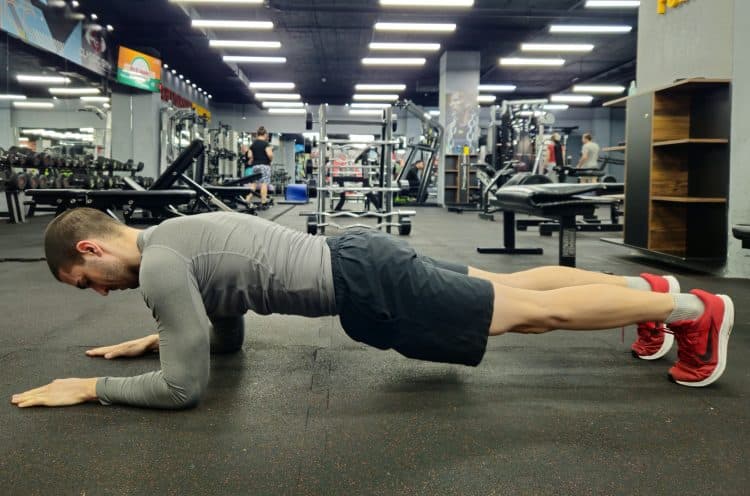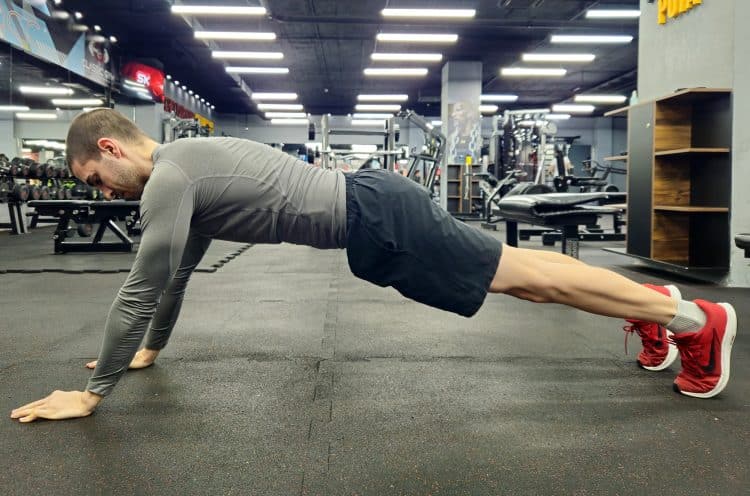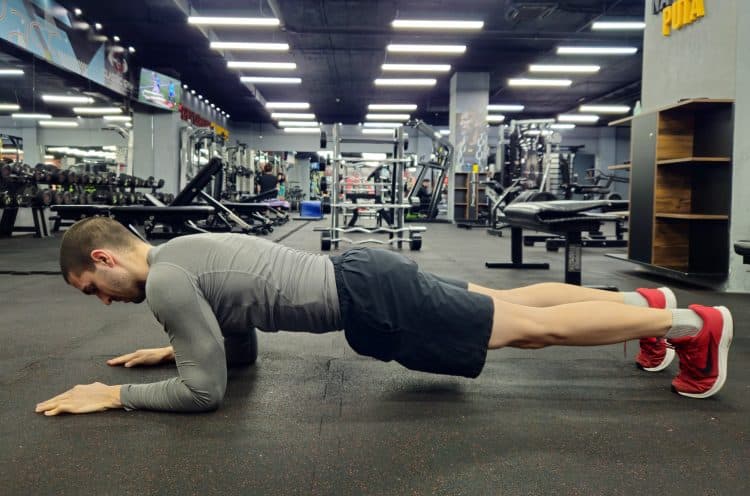The continual decline in average forearm and grip strength with age is largely a result of insufficient physical activity and sedentary jobs.
This is a significant problem, as a study confirmed a relationship between grip strength and health status in the elderly. (1)
With a decade’s worth of practical experience, I can confidently say that one of the best exercises for strengthening the forearm is the forearm push-up.
Beyond functionality and strength improvements, this exercise can also improve lower arm aesthetics. While biceps usually take the spotlight, forearms and triceps contribute to overall arm width even more.
In this article, I’ll tell you how to perform forearm push-ups correctly, give you tips, discuss common mistakes to avoid, and explore the best alternatives.
What is a Forearm Push-Up?
The forearm push-up is a variation of the regular push-up, which is among the most popular exercises in the world. Unlike traditional push-ups that involve only placing your hands on the ground, this exercise requires positioning your lower arms, including your hands, on the floor.
Level Up Your Fitness: Join our 💪 strong community in Fitness Volt Newsletter. Get daily inspiration, expert-backed workouts, nutrition tips, the latest in strength sports, and the support you need to reach your goals. Subscribe for free!
This variation presents a unique challenge since it emphasizes the triceps and forearm flexors. The forearm push-up requires coordination, strength, and stability, making it challenging for beginners.
I don’t include forearm push-ups in my clients’ training programs until they can perform three sets of 10 regular push-ups.
It is a bodyweight exercise, meaning these don’t need any equipment and can be performed anytime, anywhere. The significance of these exercises becomes evident when you aim to follow a consistent fitness routine without relying on the gym.
How To Do Forearm Push-Ups: Step-By-Step
Now it’s time to learn the forearm push-up:
Step One — Take the Starting Position
Get into a low plank position with your forearms on the ground. Hands and arms should be parallel and shoulder-width apart.
However, unlike the traditional plank position, the elbows should be slightly in front, not directly under your shoulders — approximately below the neck. Keep your legs straight behind you.
Pro Tip: Activate your core muscles to establish stability and avoid sagging your hips or arching your back.
Step Two — Extending your Arms
Push yourself up by extending your elbows. As you do this, exhale.
Pro Tip: Don’t lock your elbows at the top of the movement. That will help you to keep your elbows safe and put all the focus on your triceps and chest.
Step Three — Controlled Descent
Flex your elbows to return to the starting position. Don’t crash your elbows into the floor, but control your weight.
Pro Tip: Spend 3 seconds on the eccentrics. The descent is very important in this exercise for strength and muscle gains.
Step Four — Repeat
I usually tell my clients to do eight to 10 repetitions. Yet, proper form is much more important than the number of reps. For example, it’s better to do six reps with perfect form than to risk injury by doing more using poor form.
Watch the following video where Filip Maric demonstrates the forearm push-up technique:
Muscles Worked During Forearm Push-Ups
This push-up variation primarily works the triceps and forearm muscles, such as flexor carpi radialis. The triceps brachii muscle consists of three parts — the medial, lateral, and long head.
In my experience, you will feel more lateral and medial tricep heads (outer region) during forearm push-ups. Still, the long head is also very involved in the movement.
The secondary muscles involved are:
- Front delts (shoulders)
- Chest
- Brachioradialis
- Core
Tips For Performing Forearm Push-Ups
Let’s cover tips that will make forearm push-ups easier and more effective:
Level Up Your Fitness: Join our 💪 strong community in Fitness Volt Newsletter. Get daily inspiration, expert-backed workouts, nutrition tips, the latest in strength sports, and the support you need to reach your goals. Subscribe for free!
Warm-Up Adequately
You have to warm up. Shortening the training session by 10 minutes is better than starting without a warm-up.
Before attempting forearm push-ups, you must warm up your muscles and cardiovascular system. Warming up the body will improve joint mobility and muscle elasticity, which can help prevent injury (2). Light cardio activities like treadmill and stationary bike are great places to start.
Focus on Mind-Muscle Connection
Concentrate on engaging the targeted muscles (triceps and pecs, in this case) throughout the exercise. This mental connection enhances muscle activation, leading to better results. (3)
Pay Attention to Breathing
I must be honest here. Although I constantly remind my clients to breathe correctly, I often forget to breathe during exercises, which is my biggest training mistake. Don’t be like me.
Maintain a steady breathing pattern. Inhale during the descent and exhale during the ascent. This will optimize oxygen flow and support muscular endurance.
Change Hand Placement
You can’t experiment too much with forearm push-ups, but changing hand placement occasionally is beneficial.
You can go wider to target the chest and narrower for the triceps. Nevertheless, do not deviate significantly from regular hand placement to avoid elbow, wrist, and shoulder strain.
Common Mistakes During Forearm Push-Ups
Here are some common errors my clients often make when doing forearm push-ups. These mistakes reduce the effectiveness of the exercise and can lead to injury.
Sagging Hips
Keep your hips in line with your shoulders and heels. This applies to every push-up and plank variation, not just forearm push-ups.
Sagging hips have a doubly negative effect. This position can trigger lower back pain and make the exercise less effective.
Flaring Elbows
Flaring elbows are among the most common causes of shoulder injury, both during push-ups and bench press. Shoulders are very unstable when elbows flare out to or around 90 degrees. Ensure your elbows are tight to your sides during the movement.
Incomplete Range of Motion
A full range of motion strengthens muscles, tendons, and ligaments. So, why would you limit your potential?
Perform the full range of motion to maximize muscle engagement.
Rounding the Back
Never round your back significantly (except when doing Jefferson curls) because you risk injury and limit the exercise’s efficacy.
Fast, Uncontrolled Movements
Avoid rushing through the repetitions. It’s easier and may seem like a shortcut, but that way, you fail to take full advantage of exercise.
Best Forearm Push-Ups Alternatives
Suppose you can’t perform a forearm push-up because a recent injury limits it, or you just want to add more forearm exercises to your workout routine. In that case, I recommend the two exercises listed below.
Together with forearm push-ups, these exercises significantly enhanced my forearm and wrist strength, enabling me to surpass my previous deadlift personal best, which eluded me due to insufficient grip strength.
Diamond Push-Ups
Like all other push-up variations, the diamond push-up is a compound exercise. Of all the variations, this one focuses most intensely on the triceps, while the outer portion of the pecs (pectoralis major) is less involved.
How To:
- Begin in a high plank position.
- Form a diamond shape with your hands directly under your chest. Your index fingers and thumbs should be touching.
- Lower your chest towards the hands by bending your elbows.
- Keep your body in a straight line from head to heels.
- Push through your palms to return to the starting position without locking your elbows.
Pro Tip: Focus on contracting the triceps and inner chest.
Find out everything about diamond push-ups in our dedicated guide!
Reverse Wrist Curls
My two favorite forearm isolation exercises are the dumbbell reverse wrist curl and plate pinch.
As soon as I notice that a client has a weak grip (usually during assessment), I immediately include the dumbbell reverse wrist curl in the training program at least twice a week. Generally, the results are very quick.
How To:
- Sit on a flat bench.
- Take a dumbbell in each hand, palms facing the floor.
- Place your forearms on the bench and let your wrists hang over the edge of the bench.
- Lift the dumbbells by flexing your wrists upwards.
- Hold for a second.
- Lower the dumbbells toward the floor.
Pro Tip: Focus on contracting the forearms during the concentric phase. If you can’t control the dumbbells, reduce the weight and try one-arm wrist curl instead of using both hands simultaneously.
Want to learn more about reverse wrist curls? Check the exercise page.
Wrapping Up
Forearm push-ups are excellent for those aiming to improve forearm and tricep strength. It is an inevitable part of a calisthenics workout, but I often incorporate it in hypertrophy training, too. It targets multiple muscle groups and promotes overall upper-body strength.
References
- Musalek C, Kirchengast S. Grip Strength as an Indicator of Health-Related Quality of Life in Old Age-A Pilot Study. Int J Environ Res Public Health. 2017 Nov 24;14(12):1447. doi: 10.3390/ijerph14121447. PMID: 29186762; PMCID: PMC5750866.
- Fradkin AJ, Gabbe BJ, Cameron PA. Does warming up prevent injury in sport? The evidence from randomised controlled trials? J Sci Med Sport. 2006 Jun;9(3):214-20. doi: 10.1016/j.jsams.2006.03.026. Epub 2006 May 6. PMID: 16679062.
- Calatayud J, Vinstrup J, Jakobsen MD, Sundstrup E, Brandt M, Jay K, Colado JC, Andersen LL. Importance of mind-muscle connection during progressive resistance training. Eur J Appl Physiol. 2016 Mar;116(3):527-33. doi: 10.1007/s00421-015-3305-7. Epub 2015 Dec 23. PMID: 26700744.
Interested in measuring your progress? Check out our strength standards for Bench Press, Wrist Curl, Push Ups, and more.











